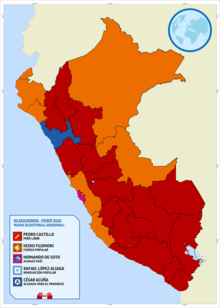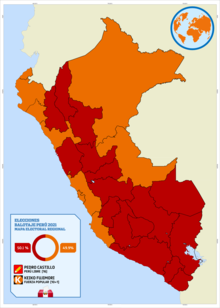2021 Peruvian general election
[105] In 2019, BBC News wrote that "Peru is perhaps where [Odebrecht] has caused the most severe crisis" and that "[t]he scandal has discredited virtually the entire political elite of the country, as all major parties and players have been implicated.[1] Forsyth criticized the COVID-19 lockdowns of the Peruvian government, saying that they caused economic distress and that the National Emergency Operations Center (COEN) should be activated for a civil-military partnership to combat further infection.[126][127] On 24 February 2021, following an approach to advise Francisco Sagasti on the COVID-19 pandemic management in Peru, Hernando de Soto announced the first shadow cabinet in Peruvian history.[131] Political scientist Paula Muñoz of the Universidad del Pacífico described Forsyth as "a pro-business guy", while Americas Quarterly wrote "his views on big economic issues are less clear."[120] In contrast, Mendoza criticized the neoliberal policies instituted in Peru since the 1990s, demanded "the decommodification of goods like health, education, and housing", and promoted the government funding of sustainable agricultural and energy projects, all while protecting the environment.[149] Pedro Castillo also condemned the killings during a rally in Huánuco, expressing solidarity towards the relatives of the victims and also urging the National Police to investigate the attack to clarify the events.[1] Regarding the first round of presidential elections, Javier Puente, assistant professor of Latin American Studies at Smith College in the North American Congress on Latin America wrote: "With a baffling number of candidates – 18 in total – the 2021 presidential ballot included convicted felons, presumed money launderers, xenophobes, a fascist billionaire, an overrated and outdated economist, a retired mediocre footballer, a person accused of murdering a journalist, and other colorful figures.[28][161] The COVID-19 pandemic exasperated these disparities even further, with rural Peruvians feeling a sense of abandonment by the government as trade and trans-regional travel were prohibited, fueling increased distrust and autonomy among interior regions of the nation."[161] Sociologist Maritza Paredes of the Pontifical Catholic University of Peru shared similar thoughts, saying: "People see that all the natural resources are in the countryside but all the benefits are concentrated in Lima.[165] The existing disparities in Peru caused a "globalization fatigue" according to Asensio, resulting in a polarization between rural and urban areas that saw differing priorities with lifestyle, economics and politics.[1] These sentiments were especially apparent during the second round of elections when establishment politicians from urban areas characterized and criminalized the lifestyles of rural Peruvians who felt that neoliberalism damaged their economic, social and cultural conditions.[1] Fujimori's response to Castillo's victory was to portray her movement as defending democracy and assumed a nationalist image, adopting the Peru national football team uniform and colors during rallies."[155] As the second round of elections approached, Fujimori's campaign used fearmongering tactics to gain support of the middle and upper classes in Lima, accusing Castillo of attempting to institute communism in Peru and to follow the path of Hugo Chávez and Nicolas Maduro in Venezuela.[166] Olga González, associate dean of the Kofi Annan Institute for Global Citizenship at Macalester College, stated that the situation is more complex than "binaries" between social classes, although she acknowledged that such dichotomies "speak to how polarized the country is.[170][173][172] Le Monde diplomatique wrote, "The privately owned media torpedoed Castillo incessantly with fake news, and not without rattling the Shining Path scarecrow".[176] Grupo La República shareholder Gustavo Mohme Seminario said that the firing occurred shortly after Ospina had a conversation with Keiko Fujimori and other news editors.[176] Mohme criticized the dismissal of Ospina, saying: "I do not want to be a silent troupe of these legal shenanigans that seeks to arbitrarily impose who will assume the reins of the main television channel in the country.""[176] Members of Cuarto Poder, an investigative journalism program on América TV, had their letter to the board of directors leaked in May 2021 where they said that Ospina's dismissal "represented serious damage to the work we do and to the image of the program", and accused her replacement, Gilberto Hume, of having an agenda against Castillo and in favor of Fujimori, writing: "Within that conversation it was implicit that (Hume) asked us to support the candidate of Fuerza Popular to the detriment of the candidate of Free Peru."[179] Shortly after polls closed on 6 June, the journalists of Cuarto Poder who sent a letter criticizing alleged censorship were fired by La República's América Televisión and El Comercio's Canal N.[178] The first round was held on 11 April.[20] The Peruvian Nationalist Party of former President Ollanta Humala and National Victory of George Forsyth (who led polling for the presidential election earlier in the year) failed to win seats as well.[173] A letter signed by almost one-hundred retired officers of the Peruvian armed forces was written calling on current military leaders in Peru to refuse recognizing the election of Castillo into the presidency.[201][197][173][199][200] According to Cornell University professor of Latin American politics Kenneth Roberts, "[w]hen the credibility is called into question the way it has been by Trump and the Republicans in the U.S., it creates a bad example that other leaders and countries can follow, providing a template to change results they don't like."[199] On 18 June, former Supreme Court President Javier Villa Stein filed a complaint for protection by describing the ballot vote as "questioned", arguing an alleged "electoral process flawed by various acts that undermine the popular will" and asking the judiciary branch to "declare the election void.[214] On 28 June, Fujimori traveled to the Government Palace and personally delivered demands to President Francisco Sagasti to initiate an audit of the results by international entities.[171] On 30 June, several members of the Popular Force party traveled to the OAS Building in Washington, D.C., to publicize the voter fraud claims, with sociologist Francesca Emanuele condemning them as "coup plotters" during a press conference.The National Penitentiary Institute and Peruvian Navy announced an investigation, confirming that Montesinos made two phone calls from Callao Naval Base where he is jailed, on 10 and 23 June to unauthorised persons coordinating the effort to overturn the election.[170][221] According to IDL-Reporteros, Montesinos suggests that the documentation would reach President Joe Biden and that his administration would condemn the election as interference from Cuba, Nicaragua, and Venezuela, subsequently giving Fujimori's claims of fraud more weight.[221] Lourdes Flores, leader of the Christian People's Party, which supported Fujimori in the election, argued carrying out her own analysis of certain electoral acts, concluding that there was a mechanism to "improperly incline the vote" in favor of Pedro Castillo.On its Twitter account, JNE rejected Arce's allegation of bias as "offensive", and said its judges were not allowed to resign in the middle of reviews of cases, so he would be suspended instead, and a provisional replacement found "to avoid delaying our work."In the wake of Arce's resignation, a lawyer representing Fujimori said that the government should consider asking the Organization of American States (OAS) to audit the electoral process, as was done during the 2019 Bolivian political crisis.






























Pedro CastilloKeiko FujimoriFree PeruPopular ForceDina BoluarteVladimir CerrónLuis GalarretaPatricia JuárezregionprovinceFrancisco SagastiPurple PartyCongress of PeruPopular RenewalRafael López AliagaPopular ActionMesías GuevaraCésar AcuñaGo on CountryTogether for PeruRoberto SánchezWe Are PeruPodemos PerúJosé LunaJulio GuzmánPolitics of PeruConstitutionExecutivePresident of PeruVice Presidents of PeruPrime Minister of PeruGustavo AdrianzénCabinetMinistriesLegislatureCongress of the RepublicPresidentEduardo SalhuanaJudiciarySupreme Court of the RepublicSuperior Courts of JusticeCourts of First InstanceCourts of PeaceNational Board of JusticeConstitutional CourtPublic MinistryOffice of the Public Defender(Ombudsman)Central Reserve BankElectionsElectoral systemElectoral Processes (ONPE)Jury of Elections (JNE)National Registry (RENIEC)Administrative divisions24 departments1 constitutional province1 special regime province25 regional governments1 Metropolitan Municipality196 provinces1874 districtsDistrict municipalitiesPopulated centers of PeruForeign relationsMinistry of Foreign AffairsDiplomatic missions ofin PeruNationality lawPassportVisa requirementsVisa policyvice presidents2016 electionsNational Office of Electoral ProcessesNational Jury of Electionstwo-round systemopen listproportional representationD'Hondt methodAndean ParliamentMartín VizcarraPresident of the Republic of Peruconstitutional reformGo on Country – Social Integration PartyNational VictoryHernando de SotoGeorge ForsythYonhy LescanoVerónika MendozaDaniel UrrestiPresident of the Institute Liberty and DemocracyMayor of La VictoriaMember of CongressJaime SalomónMaría Teresa CabreraAlliance for ProgressPeruvian Nationalist PartyOllanta HumalaDaniel SalaverryGovernor of La LibertadCajamarcaSecretary General of the Office of the Prime MinisterLima City CouncilmanLa LibertadLuis IbericoFlor PabloAlberto OtárolafootballHarold ForsythLa Victoria DistrictNational RestorationRonda CampesinaShining PathPossible PeruPedro Pablo KuczynskiMOVADEFAlberto FujimoriFujimorismoOdebrecht scandalPeruvian CongressAlfredo BarnecheahighlandsMercedes AraozManuel Merinoseries of protestsdemocratic socialist